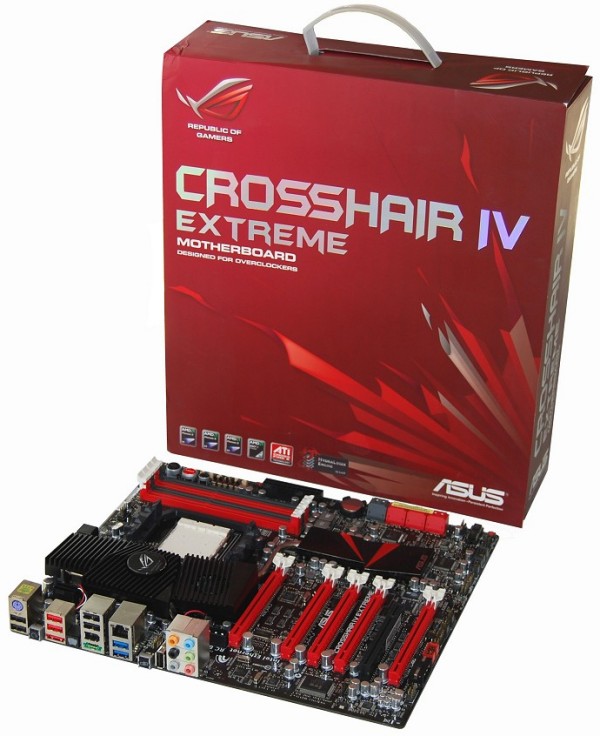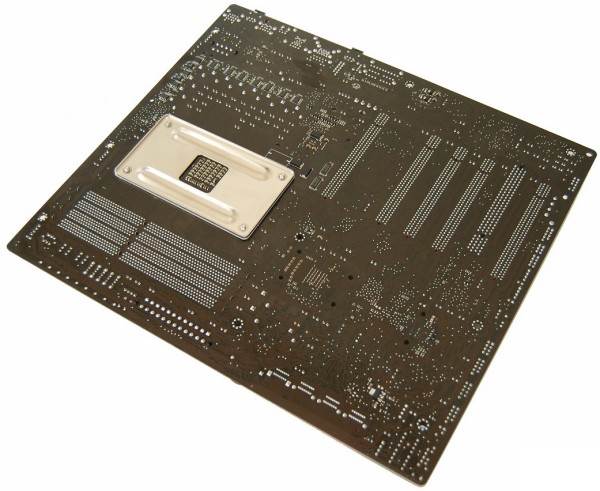Features & Specifications
The Asus Crosshair IV Extreme is equipped with the AMD 890FX chipset and the SB850 southbridge. Board features include support for ATI CrossFireX technology, thirteen USB 2.0 ports, USB 3.0, Firewire, SATA 6Gb/s, eSATA (SATA On-the-Go), 8-channel HD Audio, ROG iDirect, RC Bluetooth, USB BIOS Flashback, CPU Unlock Support and gigabit LAN.

The Crosshair IV Extreme also has four DDR3 DIMM slots with support for 16GB of RAM (non-ECC, un-buffered) running at 1600/1333/1066, while DDR3-2133 and 2000 can be achieved through overclocking.

The board is populated with five PCI Express 2.0 x16 slots, providing the Crosshair IV Extreme with impressive multi-GPU capabilities. All five slots are wired for full x16 bandwidth, though depending on the configuration, they may not be able to utilize x16 speeds.

The full x16 bandwidth is available for dual or triple card configurations, however quad card setups supported by CrossFireX technology are limited to x16 bandwidth on the primary and secondary cards, while the third and fourth cards have x8 bandwidth.
Note that the Lucid HydraLogix engine is wired to the second, fourth and fifth PCI Express x16 slots. The first and third slots are connected directly to the 890FX north bridge and should be used for CrossFire setups to avoid latency introduced by the HydraLogix engine.

Asus has implemented an interesting feature called PCIe x16 Lane Switch, which lets you manually disable PCIe expansion cards installed in each individual PCIe x16 slot. This is ideal for benchmark tests when comparing the performance different configurations as it allows quick changes without having to remove cards.

The high definition 7.1-channel audio is backed by the Realtek ALC889 HD Audio codec, featuring optical S/PDIF via the I/O panel. Many motherboard manufacturers have used the Realtek ALC889 audio codec, so we're accustomed to finding it on high-end motherboards.

Asus opted for the Intel 82583V Ethernet controller which uses the PCI Express bus. Wireless LAN is absent on the Crosshair IV Extreme, but this is common for desktop motherboards, so users will have get an expansion card if Wi-Fi is necessary.


Firewire comes as part of the package thanks to the inclusion of VIA's VT6315N controller. There are two IEEE 1394a ports, one of which is located on the I/O panel. A total of 13 USB 2.0 ports are offered (four on the I/O panel), while NEC's D720200F1 chip powers two USB 3.0 ports.

As mentioned previously, the SB850 southbridge improves upon storage, supporting six SATA 6Gb/s devices. Furthermore, SATA RAID 0, RAID 1, RAID5, RAID 10, and JBOD are also possible, providing users with a great deal of flexibility. Along with the SB850 southbridge, Asus has included a pair of JMicron JMB363 controllers.

The JMicron JMB363 controllers each powers a pair of SATA (3Gb/s) ports. While one controller provides two onboard SATA ports (for a total of eight), the second is wired to eSATA ports on the I/O panel for SATA On-the-Go.
The RC Bluetooth function is an interesting new tool that lets you remotely overclock and monitor your system through mobile devices that support Bluetooth, including Windows Mobile 6.0/6.1/6.5, Symbian, Android 2.0 or higher, as well as the iPod touch, iPhone and iPad courtesy of the ROG iDirect app.

BIOS Flashback is another enthusiast-oriented feature that lets you keep two different BIOS versions for different purposes. For instance, one version can be for extreme overclocking, while the other for stable use. Configurations are kept separately and are switchable with a simple one-touch setting.

Finally, like most motherboard manufacturers, Asus has created a way to unlock the dormant cores of certain AMD processors, a feature that was denied by the SB850 southbridge. Using Asus' CPU Unlock, you can turn a Phenom II X2 into a full-blown quad-core processor, and you know how well that goes.
